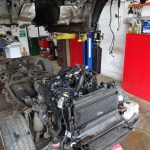It’s fair to say that we here at Famous Four, along with many modern era Range Rover owners, rate the TDV8 series of engines very highly with their plentiful power, huge torque and relatively(!!) frugal fuel economy for such a big power unit. Like any engine, though, sometimes things go wrong and the TDV8 is no more immune than any other powerplant fitted to Land Rover’s range.
Tight Fit!
Land Rover only fitted the TDV8 engine in the Range Rover Sport (first generation) from 2007 to 2010, leaving the range without V8 diesel option for the last three years of its life. When you undertake major engine work on a 3.6 Litre TDV8 model it’s easy to see why, the big V8 diesel engine occupies close to every square inch of space in the engine bay!
No better is this illustrated than when you change a turbocharger on one of these beasts, a task our workshop were given recently. Our intrepid technician, Luke, began the mammoth task of lifting the body off the chassis to access the engine and turbocharger. As involved as this sounds, the Discovery 3/4 and Range Rover Sport of this era were designed to facilitate this, with the electrics, ancillaries and pipework all conveniently disconnecting between the body and chassis. Upon removal of the easily located mounting bolts, the entire bodyshell lifts off with the help a workshop lift located under the jacking points. It’s a job we have done quite a few times on both models to change engines and parts that are not accessible from the engine bay or underside.
Changing the Turbocharger
As you can see from the pictures of the bodyshell engine bay area, and the engine sitting on the chassis, the engine is a mighty tight squeeze! The turbochargers, there’s one per bank of cylinders, are tucked down and away under the body on this model meaning a body-off lift is the only way to access them. The pictures of the old turbo vs. the replacement unit clearly show a major failure. Although not visible, there was a huge amount of slop in the impeller shaft, showing a total failure of the bearings, resulting in oil escaping into the inlet tract of the engine. This usually leads to contamination of the intercooler and intake hoses meaning not only a turbocharger change but also a lot of cleaning to do. Thankfully the hoses are removed anyway, and the radiator/intercooler assembly is easy to get to without the body in the way. The turbocharger itself is nestled at the back of the engine, packed very tightly into place as can be seen.
While jobs like this might appear daunting at first glance, patience and a methodical approach are the order of the day. At Famous Four our technicians are trained and qualified to carry out every job from a routine service to complex jobs such as these, as well as detailed and exacting restoration work. We pride ourselves on quality work at affordable prices and hope we can help you care for your Land Rover or Range Rover.
More information at: https://www.famousfour.co.uk/wshop






